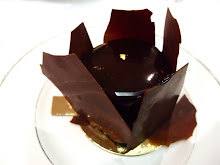
Last year's holy buns (photo by Fiona Beckett)

This year's hot cross loaf (the buns were all snaffled up before photos could be taken)
Being of Norwegian-Irish-Scottish-Jewish-Lithuanian-German extraction I've stopped crossing my buns.
What inspired such subversive behaviour in the week leading to Easter? Misplacing my piping bags. And out of sheer laziness I decided to forego making my own piping bag from silicone paper and just skipped the wobbly white crosses altogether this year. Not Cross Buns taste just the same as Hot Cross Buns, and come to think of it a pinch of heretical cardamom made its way into this spiced spelt dough. Hot cross bun purists will tut and shake their heads but I go by what tastes good, not some arbitrary notion of culinary tradition. Besides M&S are putting apples and cranberries in their buns so I'll stick to my cardamom thank you very much.
Anyway! These slow-fermented Not Crossed but rather tasty buns are suitable for lazy Sunday breakfasts so I hope you'll give them a whirl, with or without the crosses, the spelt, the cardamom...
Not cross buns (adapted from the Leiths bible standard hot cross bun recipe)
Ingredients:
200ml milk, scalded (ie, brought to boiling point and then allowed to cool)
85g butter
300g refined spelt flour
150g wholemeal spelt flour
55g caster
1/2 tsp salt (1 tsp if using unsalted butter)
1 generous teaspoon mixed spice
1 tsp cinnamon
1/2 tsp cardamom (not strictly kosher but who cares)
20g fresh yeast or 7g sachet dried yeast
2 medium eggs, lightly beaten
100g sultanas
Method:
I slow ferment this dough overnight before baking off the buns/loaf. You can of course make them in a few hours but I find the slow fermentation adds a complex flavour and reputedly the slower the fermentation the more digestible the buns or loaf...
First, scald the milk along with the butter and cool to less than 50°C. Above 50°C and the heat will kill off the yeast so if you don't have a digital thermometer stick your finger in and the milk should feel lukewarm but not hot.
Meanwhile sift the flours, spice, salt and sugar in a large bowl. If using dried active yeast add it at this stage. If using fresh yeast, mix with 1 teaspoon of sugar in a small bowl. It should dissolve after a few minutes, and foam slightly - this is a sign the yeast is active. A good sign!
When the milk has cooled sufficiently, make a well in the centre of the dried ingredients and add the milk, butter, eggs, and (if using) fresh yeast.
Stir through and bring together with a large spoon. The great thing about spelt is it doesn't require much kneading. The dough should be quite sticky but simply stir through with your spoon for 5 minutes. You should see the dough become pliable and a little stretchy from the gluten strands forming.
Place the dough in a lightly oiled bowl, large enough to allow the dough to double in size, and then cover with oiled clingfilm and refrigerate for 12-18 hours, depending on when you're ready to bake the buns.
When the time comes to start shaping the dough into buns, take the dough out of the fridge and allow it to 'come to' temperature. Ie, let it warm up for 1 hour.
Meanwhile, soak the raisins in enough water to cover and drain the excess liquid off after 15 minutes.
Roll your dough out into a rough square or rectangle shape and scatter the raisins over. Bring the dough together like a parcel, sealing it off, and then just give it a couple of kneads to seal the dough and make sure the raisins haven't all clumped in one section of the dough.
Using a sharp un-serrated knife, slice the dough into 12-16 bun shapes of equal size. I weigh mine to 60g portions so they all bake evenly but you don't have to be as fastidious a fuss-pot as me.
Roll the buns into as round shapes as you can by gripping each bun in the palm of your hand, cupping your whole hand over it and then swirling around on your work surface in tight circles for a few seconds. This creates a tight;y structured bun and a round, even shape. I found I had too much dough to make buns for one tray to fit in my small oven so the remaining quarter of the dough I shaped into a mini loaf and baked after the buns were finished.
Place the shaped buns a couple of centimetres apart on the baking sheet and cover with a sheet of oiled clingfilm on top, allowing the buns to double in size in a warm place. This should take 30-40 minutes, but keep checking after 25 minutes. The buns will be ready to bake when you poke one and the imprint of your finger remains, ie. it doesn't spring back.
Finally, preheat the oven to 220°C. Brush each bun with a little milk - this will help to make a soft crust when the buns bake.
Place the baking sheet on an upper-middle shelf of the oven and turn the heat down to 200°C after 5 minutes, bake a further 15 minutes. Keep an eye on them so they don't burn. The buns will be done when they're golden brown, and sound hollow when you tap them. For the loaf allow an extra 10-15 minutes depending on the size of the loaf.
That's all there is to it. Freeze the buns or loaf for future use as they refresh really well in a 150°C oven for 10 minutes...
















































